Qiuzziz has revolutionized the way educators create and deliver engaging assessments. This powerful online learning tool combines the thrill of gamification with the rigor of educational content, making it a go-to platform for teachers worldwide. In this article, we’ll explore 10 proven strategies for crafting viral educational quizzes that captivate students and enhance learning outcomes.
Before diving into the strategies, let’s consider the key benefits of using Quizizz:
- Increased student engagement through interactive, game-like quizzes
- Real-time assessment and instant feedback for both teachers and students
- Flexibility to create custom quizzes or use pre-made content from a vast library
- Easy integration with popular learning management systems
By mastering these strategies, you’ll be able to create quizzes that not only assess knowledge but also inspire curiosity and foster a love for learning. Whether you’re a seasoned Qiuzziz user or new to the platform, these tips will help you unlock the full potential of this dynamic educational tool.
Understanding Virality in Educational Content
Creating viral educational content is a unique challenge that blends engaging elements with valuable learning experiences. In the context of Qiuzziz, viral quizzes spread rapidly among educators and students, often through social sharing and word-of-mouth recommendations.
What makes educational content go viral? It’s a mix of factors:
- Relevance: Content that addresses current topics or pressing educational needs
- Engagement: Qiuzziz that are fun, interactive, and visually appealing
- Usefulness: Material that provides clear educational value
- Shareability: Easy-to-share format and results that encourage social posting
For Qiuzziz quizzes, virality often starts within the classroom. When students enjoy a quiz, they will likely talk about it with friends or share it on social media. Teachers who find a quiz effective are prone to sharing it with colleagues or in online educator communities.
The role of social sharing in spreading educational resources cannot be overstated. Platforms like Twitter, Facebook, and teacher-specific forums act as amplifiers for great content. When a Qiuzziz creation resonates with educators, it can quickly reach thousands of classrooms worldwide.
Remember, viral educational content must balance entertainment with learning objectives. The goal is to create quizzes that students want to take repeatedly, reinforcing knowledge while having fun. By understanding these principles of virality, you can craft Qiuzziz content that not only educates but also spreads like wildfire through the educational community.
Qiuzziz’s Strategy 1: Know Your Audience
Creating a viral Qiuzziz starts with understanding your audience. Tailoring your content to the specific needs and interests of your students is crucial for engagement and effectiveness.
First, identify your target age group and subject area. A quiz for elementary math students will differ greatly from one for high school literature. Consider the following:
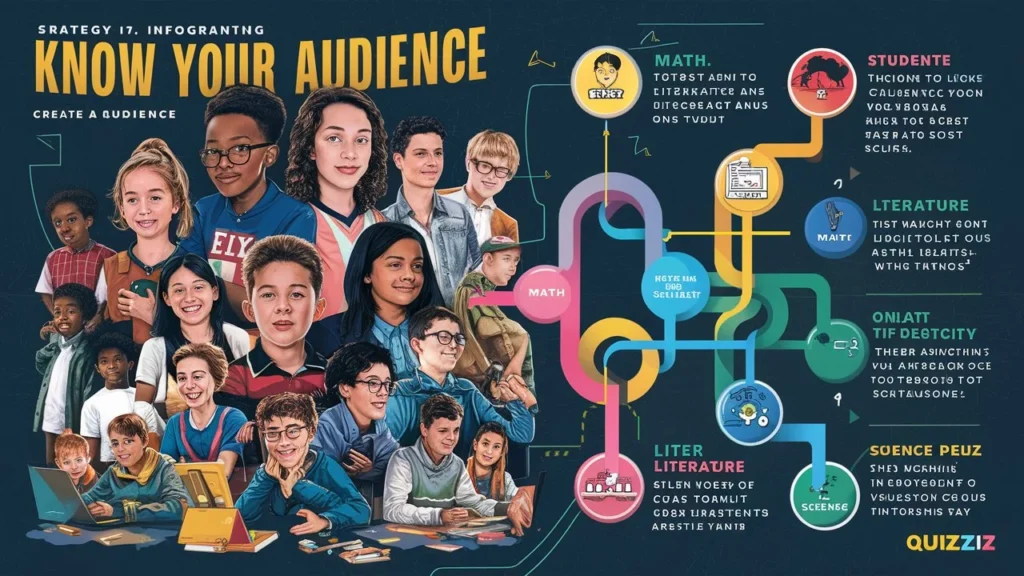
- Age-appropriate language and complexity
- Relevant examples and context
- Curriculum alignment
Next, think about learning styles and preferences. Some students are visual learners, while others prefer text or auditory input. Qiuzziz allows you to cater to various learning styles:
- Use images for visual learners
- Include text-based questions for readers
- Add audio elements when possible
Tailoring difficulty levels is also key. A quiz that’s too easy will bore students, while one that’s too hard may discourage them. Aim for a mix:
- Start with easier questions to build confidence
- Gradually increase the difficulty of challenging students
- Include a few tough questions to stretch top performers
Remember, the goal is to create a quiz that feels personalized and engaging. When students feel the content speaks directly to them, they’re more likely to share and recommend it to others.
By knowing your audience, you can craft Qiuzziz content that not only educates but also resonates on a personal level. This connection is the first step in creating a viral educational experience that students will love and share.
Qiuzziz’s Strategy 2: Craft Compelling Titles
The title of your Qiuzziz is the first thing educators and students see. It’s your chance to grab attention and spark curiosity. A compelling title can make the difference between a quiz that goes viral and one that gets overlooked.

Here are key elements to consider when crafting your title:
- Use power words that evoke emotion or urgency
- Include numbers to suggest a specific, valuable takeaway
- Create curiosity by hinting at intriguing content
For example, instead of “Math Quiz,” try “5 Mind-Blowing Math Tricks You Need to Know!” This title uses a number, creates curiosity, and suggests valuable content.
Consider these title structures that often work well:
- How-to titles: “How to Master Fractions in 10 Fun Questions”
- List titles: “7 Surprising Facts About Ancient Egypt”
- Challenge titles: “Can You Solve These Tricky Science Riddles?”
- Benefit-driven titles: “Ace Your Next History Test with This Quick Quiz”
Remember to keep your title relevant to the quiz content. Misleading titles may get initial clicks but will ultimately disappoint users and hurt your credibility.
Lastly, don’t be afraid to use some humor or playfulness in your titles, especially for younger audiences. A title like “Grammar Ninjas: Can You Spot the Sneaky Errors?” adds a fun element that can increase engagement.
By mastering the art of title creation, you’ll increase the chances of your Qiuzziz being noticed, shared, and ultimately going viral in the educational community.
Strategy 3: Incorporate Multimedia Elements
It shines when it comes to multimedia integration. Using a mix of text, images, GIFs, and even audio can transform a simple quiz into an engaging, viral sensation.
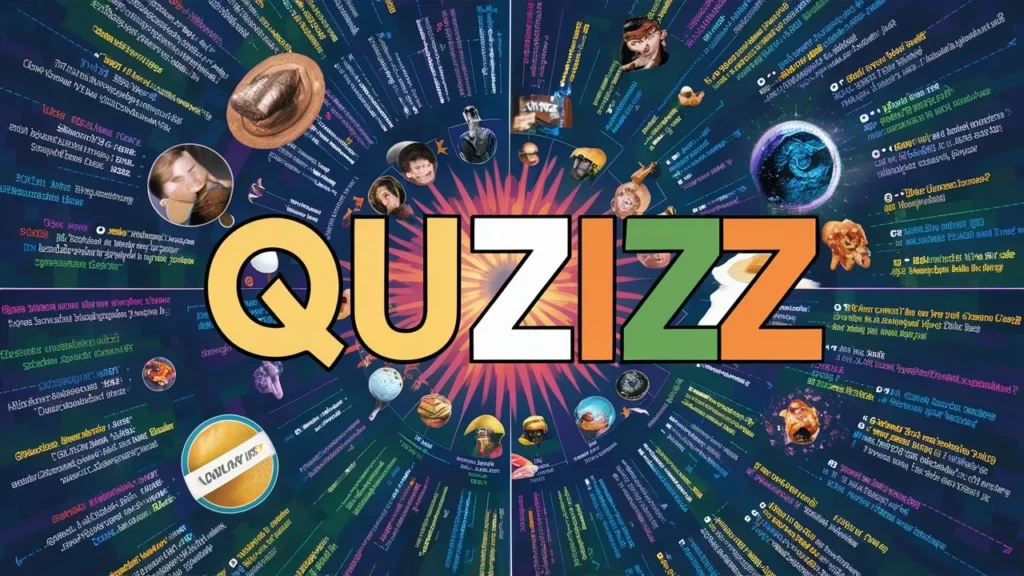
Here’s how to effectively use multimedia:
- Images: Add relevant pictures to illustrate concepts or provide visual cues. For example, use diagrams in science quizzes or maps in geography tests.
- GIFs: Inject humor and keep students engaged with carefully chosen GIFs. They work great as reaction images for correct or incorrect answers.
- Audio: When possible, include audio elements. This could be pronunciation guides in language quizzes or sound effects in music theory tests.
Remember, balance is key. While multimedia enhances engagement, overuse can distract from the learning objectives. Aim for a mix where each element serves a purpose.
Tips for effective multimedia use:
- Ensure images are clear and high-quality
- Choose GIFs that are age-appropriate and relevant
- Keep audio clips short and to the point
- Use consistent visual themes throughout the quiz
By thoughtfully incorporating multimedia, you create a multi-sensory learning experience that appeals to different learning styles. This approach not only makes your Quizizz more enjoyable but also increases its viral potential as students and teachers are more likely to share visually appealing and interactive content.
Strategy 4: Leverage Current Trends and Pop Culture
Tapping into current trends and pop culture can make your Qiuzziz instantly relatable and shareable. This strategy helps bridge the gap between academic content and students’ everyday interests.
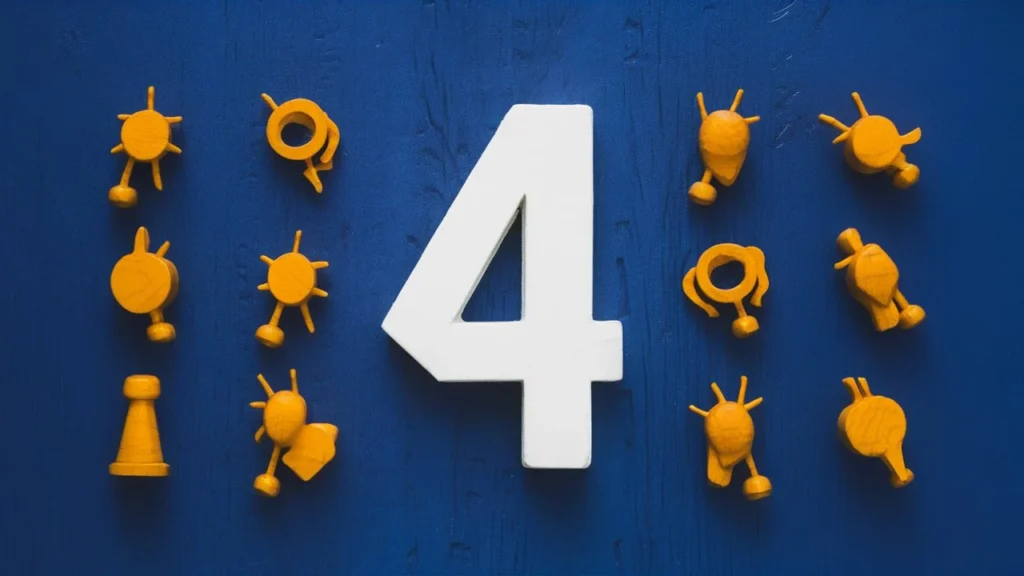
Here’s how to effectively use trends and pop culture:
- Connect quiz content to popular topics: Link questions to current events, viral memes, or trending hashtags when relevant.
- Use memes and cultural references: Incorporate well-known memes or cultural touchstones that resonate with your target age group.
- Stay up-to-date with student interests: Keep an ear to the ground about what’s popular among your students, whether it’s music, movies, or social media trends.
Examples of trend integration:
- For a math quiz: “Calculate how many TikTok dances you can learn in X hours if each dance takes Y minutes.”
- In a literature quiz: “Match these classic book characters to their modern-day social media personas.”
- For a science quiz: Use popular superhero abilities to explain physics concepts.
Remember to keep references appropriate and inclusive. What’s trendy for one group might not resonate with another.
Tips for staying current:
- Follow education-focused social media accounts
- Ask students about their interests (within appropriate bounds)
- Keep an eye on trending topics in news and entertainment
By skillfully weaving current trends and pop culture into your Qiuzziz, you create content that feels fresh and relevant. This approach can significantly boost engagement and increase the likelihood of your quiz going viral among students and educators alike.
Qiuzziz’s Strategy 5: Design for Mobile First
In today’s digital age, most students access Qiuzziz on their smartphones. Designing your quiz with mobile users in mind is crucial for creating a viral educational experience.
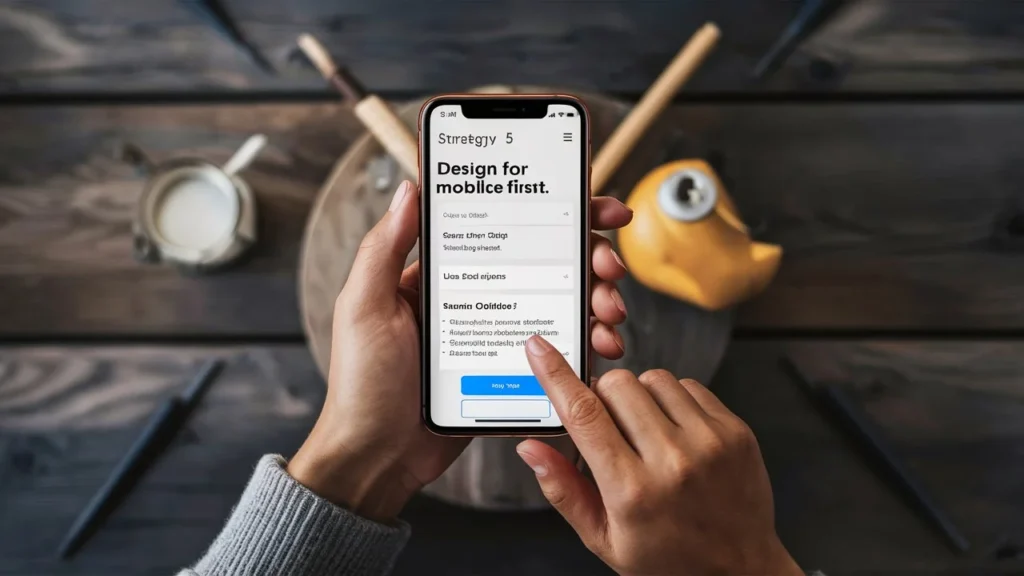
Key aspects of mobile-first design:
- Keep questions concise: Long text can be hard to read on small screens. Aim for clear, brief questions.
- Use mobile-friendly images: Choose images that are clear and easily viewable on smaller displays.
- Optimize answer options: Ensure answer choices are easy to tap with a finger.
Tips for mobile optimization:
- Test your quiz on different devices to ensure compatibility
- Use bullet points or numbered lists for better readability
- Avoid questions that require zooming or horizontal scrolling
Consider the following when crafting questions:
- Multiple choice: Ideal for mobile, easy to tap
- True/False: Quick and simple on any screen size
- Short answer: Keep input fields small and manageable
Remember, a smooth mobile experience increases the likelihood of students completing and sharing your quiz. The easier it is to use on a phone, the more viral potential it has.
By prioritizing mobile design, you’re not just accommodating preferences – you’re tapping into the primary way many students interact with digital content. This approach can significantly boost the reach and impact of your Quizizz, making it more likely to spread rapidly among students and educators.
Qiuzziz’s Strategy 6: Create a Narrative or Theme

Turning your Qiuzziz into a storytelling experience can dramatically increase engagement and viral potential. A cohesive narrative or theme ties questions together, making the quiz feel like an adventure rather than a test.
Turning your Qiuzziz into a storytelling experience can dramatically increase engagement and viral potential. A cohesive narrative or theme ties questions together, making the quiz feel like an adventure rather than a test.
Here’s how to implement this strategy:
- Develop a storyline: Create a simple plot that unfolds as students progress through the quiz.
- Use themed question sets: Group questions around a central theme or concept.
- Create character-driven quizzes: Introduce characters that guide students through the questions.
Examples of narrative-driven quizzes:
- “Escape the Ancient Egyptian Tomb”: Each correct answer helps students solve puzzles to escape.
- “Save the Endangered Species”: Players earn points to protect different animals with each right answer.
- “Time Travel Through History”: Questions take students on a journey through different historical periods.
Tips for effective storytelling:
- Keep the narrative simple and related to the subject matter
- Use consistent imagery and language throughout the quiz
- Consider adding “plot twists” for bonus questions
Remember, the goal is to make learning feel like an exciting journey. When students are invested in the story, they’re more likely to share the experience with others.
By crafting a compelling narrative or theme for your Qiuzziz, you create an immersive learning experience that students will want to repeat and share. This approach can turn a standard quiz into a viral sensation that educates and entertains in equal measure.
Qiuzziz’s Strategy 7: Utilize Gamification Elements
Gamification is at the heart of Quizizz’s appeal. By leveraging game-like features, you can create an addictive learning experience that students will want to share and replay.
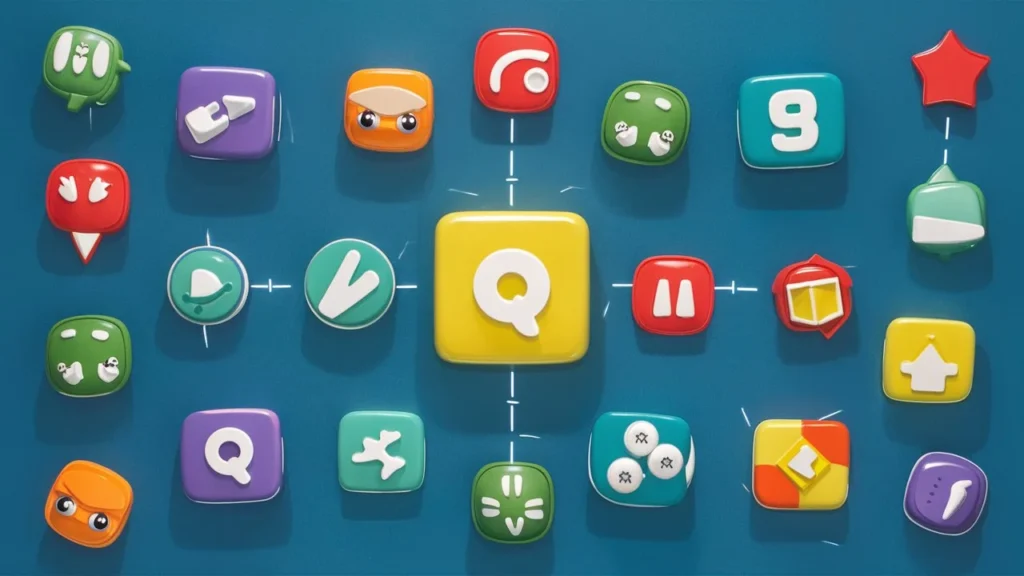
Key gamification elements to use:
- Point systems: Reward correct answers and quick responses with points.
- Leaderboards: Foster friendly competition by displaying top scorers.
- Time pressure: Add excitement with timed questions or quizzes.
- Levels and achievements: Create a sense of progress and accomplishment.
Implementing gamification:
- Use Qiuzziz’s built-in points system to reward speed and accuracy
- Enable the leaderboard feature to spark competition
- Set appropriate time limits for questions to add urgency
- Create “boss levels” with more challenging questions at quiz milestones
Tips for effective gamification:
- Balance competition with learning objectives
- Offer redemption questions to keep struggling students engaged
- Use power-ups to add an element of chance and strategy
Remember, the goal is to make learning feel like play. When students are having fun, they’re more likely to absorb information and share the experience.
You transform your Qiuzziz from a simple assessment tool into an engaging game by skillfully incorporating gamification elements. This approach not only enhances learning but also increases the viral potential of your quiz, as students will be eager to challenge their peers and share their achievements.
Strategy 8: Craft Questions That Promote Critical Thinking
Move beyond simple recall questions to create a truly viral and valuable Qiuzziz. Craft questions that challenge students to think critically and apply their knowledge.
Here’s how to implement this strategy:

- Use scenario-based problems: Present real-world situations that require analysis.
- Incorporate multi-step questions: Encourage students to think through complex processes.
- Ask “why” and “how” questions: Promote deeper understanding rather than memorization.
Examples of critical thinking questions:
- Instead of “What is photosynthesis?”, try “How would a plant’s growth be affected if kept in complete darkness?”
- Rather than “Who wrote Romeo and Juliet?”, ask “How might the story of Romeo and Juliet change if set in modern times?”
- Instead of “What is the capital of France?”, try “Why do you think Paris became the capital of France?”
Tips for crafting thought-provoking questions:
- Use Bloom’s Taxonomy to target higher-order thinking skills
- Incorporate visual elements that require interpretation
- Provide options that require careful consideration, not just guessing
Remember, challenging questions can be more engaging and memorable. When students feel intellectually stimulated, they’re more likely to discuss and share the quiz.
By focusing on critical thinking, you create a Quizizz that not only assesses knowledge but also develops important skills. This approach can make your quiz stand out, increasing its viral potential among educators looking for high-quality learning resources.
Qiuzziz’s Strategy 9: Optimize For Share ability

Creating a viral Quizizz isn’t just about content—it’s also about making it easy and appealing to share. By optimizing for shareability, you increase the chances of your quiz spreading rapidly through educational networks.
Key elements of a shareable Quizizz:
- Add social sharing buttons: Make it simple for users to share on various platforms.
- Create shareable results: Design eye-catching result screens that students want to post.
- Encourage teacher-to-teacher sharing: Include features that make it easy for educators to recommend your quiz.
Tips for enhancing shareability:
- Use catchy hashtags specific to your quiz or topic
- Create custom completion certificates that students can share
- Include a brief, compelling description of the quiz for social media posts
Make your quiz share-worthy by:
- Adding a surprising fact or “did you know” section at the end
- Including a challenge or call-to-action for others to take the quiz
- Offering different result types based on scores (e.g., “Math Wizard” or “Number Ninja”)
Remember, people share content that makes them look good or helps others. Design your quiz with this in mind.
By focusing on shareability, you’re not just creating a quiz—you’re crafting a social experience. When students and teachers find your Qiuzziz valuable and easy to share, it’s more likely to go viral within educational communities, expanding its reach and impact.
Qiuzziz’s Strategy 10: Analyze and Iterate
Creating a viral Quizizz is an ongoing process. Use data and feedback to continuously improve your quizzes and increase their viral potential.

Key steps in analyzing and iterating:
Key steps in analyzing and iterating:
- Use Quizizz analytics: Study completion rates, average scores, and question-specific data.
- Identify areas for improvement: Look for questions with low success rates or high skip rates.
- A/B test different elements: Try variations in question types, multimedia, or narratives.
- Gather user feedback: Ask students and teachers for their thoughts on the quiz.
Tips for effective analysis:
- Regularly review quiz performance data
- Pay attention to drop-off points in longer quizzes
- Compare performance across different classes or age groups
Ways to iterate based on data:
- Rephrase confusing questions
- Adjust difficulty levels to maintain challenge without frustration
- Add more engaging elements to sections with low completion rates
Remember, even small improvements can significantly boost a quiz’s viral potential.
Continuous refinement process:
- Create initial quiz
- Analyze performance data
- Gather user feedback
- Make targeted improvements
- Re-release updated version
- Repeat steps 2-5
By committing to ongoing analysis and iteration, you ensure your Quizizz stays relevant, engaging, and effective. This approach not only improves the learning experience but also increases the likelihood of your quiz becoming a viral hit in the educational community.
Best Practices For Qiuzziz Features
To create a viral educational quiz, it’s crucial to master Qiuzziz’s unique features. Here’s how to make the most of the platform’s tools:
Question Types
- Multiple choice: Great for quick assessments
- Fill-in-the-blank: Ideal for vocabulary or math equations
- Open-ended: Perfect for critical thinking questions
Use a mix of question types to keep students engaged and test different skills.
Meme Feature
- Choose relevant, age-appropriate memes
- Create custom memes for specific topics
- Use memes as rewards for correct answers
Power-ups and redemption questions:
- Enable power-ups to add excitement
- Use redemption questions to keep struggling students motivated
- Balance power-ups with learning objectives
Custom themes:
- Create themes that match your subject or narrative
- Use consistent colors and imagery throughout the quiz
- Consider seasonal or trending themes to increase relevance
Tips for effective feature use:
- Keep instructions clear and concise
- Test your quiz before sharing to ensure all features work as intended
- Use features to support learning, not distract from it
Remember, It features are tools to enhance learning and engagement. Use them thoughtfully to create a quiz that’s both educational and viral-worthy.
By mastering these features, you’ll create a more dynamic and shareable Quizizz experience. This attention to detail can significantly boost your quiz’s viral potential in the educational community.
Promoting Your Qiuzziz Creations
Creating a great quiz is only half the battle. To go viral, you need to actively promote your Qiuzziz creations. Here’s how to get your quiz in front of more educators and students:
Share on teacher forums and social media:
- Post your quiz on platforms like Twitter, Facebook, and Instagram
- Use education-specific hashtags like #EdChat or #TeacherLife
- Share in subject-specific online communities
Collaborate with other educators:
- Team up with teachers to create quiz series
- Cross-promote quizzes within your school or district
- Join Qiuzziz-focused educator groups online
Participate in Qiuzziz community challenges:
- Look for official Qiuzziz contests or themed events
- Create quizzes that align with monthly educational themes
- Engage with other creators and share feedback
Tips for effective promotion:
- Provide a brief, catchy description of your quiz
- Highlight unique features or themes in your promotions
- Offer to exchange quiz reviews with other creators
Remember to:
- Respect copyright when sharing content
- Give credit to collaborators or sources
- Respond to feedback and questions promptly
By actively promoting your Quizizz creations, you increase their visibility and viral potential. Networking with other educators can also lead to valuable collaborations and improvements in your quiz-making skills.
Consistent, strategic promotion can turn a good quiz into a viral sensation, benefiting students and teachers across the educational community.
Case Studies: Successful Viral Educational Quizzes
Analyzing popular Quizizz content can provide valuable insights for creating your viral quizzes. Let’s look at some successful examples and the lessons we can learn from them:
Case Study 1: “Meme Math Madness”
- Subject: Middle School Math
- Key Features: Used popular memes to illustrate math concepts
- Why it went viral: Blended humor with learning, highly shareable
Lesson: Incorporating pop culture can make difficult subjects more approachable and fun.
Case Study 2: “History Time Machine Challenge”
- Subject: World History
- Key Features: Quiz structured as a time travel adventure
- Why it went viral: Engaging narrative, diverse question types
Lesson: A strong theme or story can turn a quiz into an immersive experience.
Case Study 3: “Science Lab Escape Room”
- Subject: High School Chemistry
- Key Features: Puzzle-based questions, timed challenges
- Why it went viral: Gamification elements, critical thinking focus
Lesson: Adding game-like elements can boost engagement and replay value.
Common traits of viral quizzes:
- Creative use of multimedia
- Clear learning objectives
- Engaging themes or narratives
- Mix of easy and challenging questions
- High shareability factor
Remember, viral success often comes from a combination of quality content, clever presentation, and effective promotion. By studying these examples and applying the lessons to your own quizzes, you can increase your chances of creating the next viral hit on Qiuzziz.
Addressing Potential Challenges
Creating viral educational quizzes comes with its own set of challenges. Here’s how to navigate common issues:
Balancing Fun And Educational Value
- Ensure each question has a clear learning objective
- Use entertaining elements to support, not overshadow, content
- Test quizzes with students to gauge engagement and effectiveness
Avoiding Copyright Issues
- Use royalty-free images and music
- Create original memes or graphics when possible
- Cite sources for any borrowed content
- Familiarize yourself with fair use guidelines in education
Ensuring Inclusivity And Cultural Sensitivity
- Use diverse representations in images and examples
- Avoid stereotypes or potentially offensive content
- Consider global perspectives for international audiences
- Seek feedback from colleagues with diverse backgrounds
Tips For Overcoming Challenges
- Regularly review and update your quizzes
- Stay informed about copyright laws and best practices
- Be open to feedback and willing to make changes
Remember:
- Quality trumps quantity – focus on creating meaningful content
- It’s okay to iterate and improve based on user feedback
- Always prioritize student learning over viral potential
By addressing these challenges head-on, you can create Qiuzziz content that is not only viral but also ethically sound and educationally valuable. This approach ensures your quizzes contribute positively to the learning experience while avoiding potential pitfalls.
Conclusion
Crafting viral educational quizzes on Quizizz is an art that combines creativity, strategy, and a deep understanding of both the platform and your audience. Let’s recap the 10 key strategies we’ve explored:
- Know your audience
- Craft compelling titles
- Incorporate multimedia elements
- Leverage current trends and pop culture
- Design for mobile first
- Create a narrative or theme
- Utilize gamification elements
- Craft questions that promote critical thinking
- Optimize for shareability
- Analyze and iterate
These strategies, when applied thoughtfully, can significantly boost the engagement and viral potential of your Quizizz creations. Remember, the impact of well-crafted quizzes goes beyond just numbers – they can transform student engagement and make learning a truly enjoyable experience.
Key takeaways:
- Balance entertainment with educational value
- Stay current with trends and technology
- Continuously improve based on data and feedback
As you start creating and experimenting with these strategies, remember that virality in educational content is about more than just widespread sharing. It’s about creating meaningful learning experiences that resonate with students and teachers alike.
We encourage you to dive in, try new approaches, and don’t be afraid to push the boundaries of what educational quizzes can be. With Qiuzziz as your platform and these strategies as your guide, you’re well-equipped to create qiuzziz that not only goes viral but also makes a lasting impact on education.

Matthew Porter is the innovative mind behind Insuranted.com, a website dedicated to providing clear, comprehensive, and reliable information on insurance. With a passion for simplifying complex topics, Matthew aims to empower readers to make informed decisions about their insurance needs










